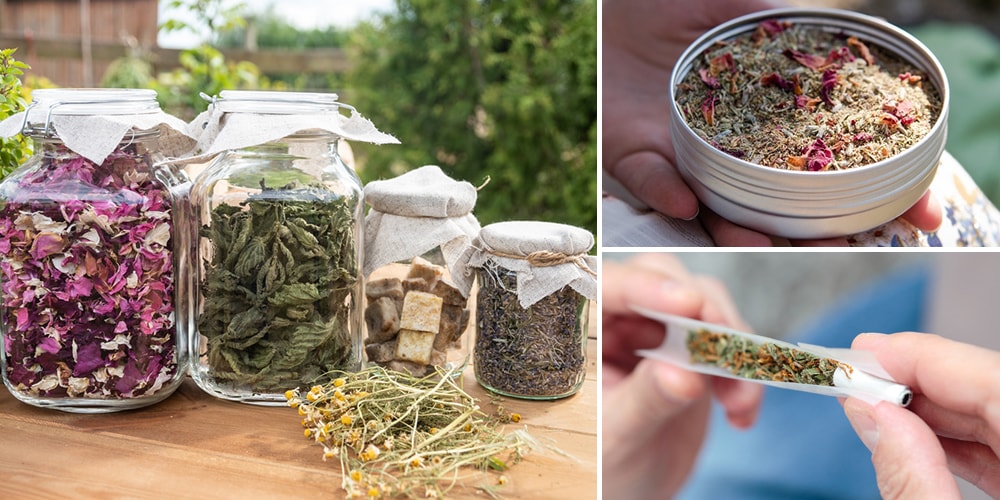
DIY Herbal Smoking Blend
Mostly done for shamanic rituals, smoking herbs has been a common practice for thousands of years. Indian healers used herbs for Ayurvedic medicine and smoking them enhances and realizes their qualities. The active substances of the plant are activated when ignited and its energy is transferred to the smoker. Deep inhalation carries its therapeutic properties to the body parts that need healing.
One of the important uses of smoking herbs is in treating respiratory problems. It is also found to alleviate migraine headaches, toothaches, nervous problems and hormonal problems.
Tobacco is a popular plant long used for smoking and is used as a trade item. It was smoked not only socially but also ceremonially such as in sealing a treaty agreement. Today, tobacco is still widely popular as the main ingredient in cigarettes despite its impending health issues.
Hemp and cannabis are also infamous smokable plants mostly used for recreational purposes. They are so potent that their legality was long put in question. Recently, all US States legalize the cultivation of these herbs provided their active component THC does not exceed the threshold amount set by law.
For purposes of healing health maladies, potent smokable herbs are the best option (and are legal too). They are used as substitutes for tobacco and help get rid of nicotine addiction. But not all herbs are meant to be smoked and even the smokable ones are not intended for long-term use. Regardless of the source, smoking can irritate the lungs, which will only create a bigger problem.
Smoke Blend Ingredients
Before engaging in the practice of smoking herbs, it will help to first research the herbs viable for smoking. Herbs also give off different tastes so you may want to experiment with what suits your taste buds best.
The most popular herbs for smoking are mullein, mugwort, red raspberry, skullcap, uva ursi and passionflower, among others. There are also flavoring herbs like peppermint, spearmint and sage to enhance its taste.
A DIY blend is typically divided into three parts: base herbs, supportive herbs and flavoring herbs.
Base Herbs
The base herb, or carrier herb, makes up about 50 to 60 percent of the blend. It is the bulk or main ingredient that carries the herbal smoke. The base herb should have a neutral and light flavor and to be easy on the throat. Good options are: Mullein, Damiana, Mugwort, Raspberry, Gotu kola, Marshmallow leaves or roots, Chamomile, Yarrow flowers.
Supportive Herbs
The secondary, or supportive, herbs comprise 30 to 40% of the blend. These herbs provide a specific therapeutic effect when smoked. When choosing a supportive herb, try experimenting with different herbs and consider their healing properties. For example, if you want a calming effect, use passionflower; and use uva ursi to clear lung inflammations. Good options are: Skullcap, Blue lotus, Passionflower, Coltsfoot, Uva ursi, Catnip, Lobelia, Wild lettuce, White sage, Wormwood.
Flavoring Herbs
The flavoring herbs and spices make the herbal smoking blend more appealing. They only take up about 10 to 20% of the mix because of their potent flavor. You can try refreshing herbs like peppermint or lavender for floral flavor. Flavoring herbs also impart their medicinal properties into the mixture. Good options are: Peppermint and spearmint, Lavender, Licorice root, Clove, Jasmine, Rose petals, Korean ginseng, Tea leaves, Sage, Thyme.
Smoke Blend Tools
Rolling Paper
To create your own smoke blend, you will need rolling paper that will hold the ingredients. You can find them in online stores and they are available in a wide variety of materials, sizes, thicknesses and burning speeds.
For this, you may opt for natural and unprocessed rolling papers, preferably without added flavors. They not only serve as a carrying vessel for the herbs but also get burned with them. Papers with prints and inks or those that are bleached are not ideal because of the toxic substances they contain.
If you are not keen on rolling your blend, there are pre-rolled tubes available for your convenience. You may also get your hands on those good old-fashioned pipes if you like.
Filter
Traditional smoking did not use filters until the early 1950s. It was designed to reduce tar, nicotine or other toxic substances that are absorbed in the lungs during smoking. They also reduce the temperature of the smoke that is drawn.
Filters also come in different types. They are mostly made of cotton tips, cardboard, slim foam or reusable plastic filters. Using filters is a personal preference.
Blend Inspirations
Mullein and Coltsfoot for Respiratory Illnesses
Mullein (Verbascum thapsus) is a light and airy herb commonly used as a base herb for smoking blends. The herb is traditionally used for treating various health problems. It is especially beneficial in soothing inflammatory pain and respiratory infections.
Coltsfoot (Tussilago farfara) is an herbal remedy for cough. It is an effective antitussive and expectorant that clears the airways and manages congestion. Using coltsfoot as a supportive herb creates a potent herbal smoke for alleviating bronchitis, laryngitis, pneumonia and other related conditions.
You can choose your own flavoring for this blend but peppermint or spearmint may be the best choice.
⇒ The Easiest Way to Defeat Seasonal Allergies, Boost Lung Health, and Calm Asthma.
Women’s Health Mullein and Raspberry Smoke Blend
Mullein (Verbascum densiflorum) is a trophorestorative herb that can correct imbalances and deficiencies in the body. The smoke from its dried leaves, combined with the astringent and alterative properties of red raspberry benefits women’s health. Raspberry is excellent in treating ovulation problems, difficult menses and other women’s reproductive health issues.
Uplifting Smoke Blend
Mix in equal parts: blue lotus, damiana, rose petals and California poppy. These ingredients are potent mood enhancers and natural antidepressants with psychoactive properties. Use this blend if you want to feel calm and relaxed. You can adjust the ratio of the blend to your preference and substitute sacred lotus for blue lotus if unavailable.
Strong Relaxant Blend
Mix skullcap with a pinch of lobelia and smoke it to induce deep sleep and relaxation. The herbs have strong sedative and calming properties that are great for insomnia and many sleep disorders. It can also reduce anxiety and depression as well as ease inflammatory pains.
Herbal Blend to Quit Smoking
Quit your tobacco addiction by smoking this DIY herbal smoke blend.
Mix finely broken dried leaves of the following herbs: mullein, uva ursi, skullcap, lobelia and mint as an optional flavoring.
Smoke the herbs for a month before removing lobelia and increasing the mullein leaf. When the tobacco craving is noticeably reduced, continue smoking mullein before totally quitting the habit.
How to Make a DIY Smoke Blend
In making your own smoke blend, the ingredients and amount is your personal preference. You can adjust how strong or weak you want the mixture and substitute the herbs you don’t like.
The ideal ratio for a DIY smoke blend is:
- 2 tbsp base herb
- 1 tbsp supportive herb
- ½ tbsp flavoring
- Crumble the dried leaves into small pieces, preferably into powder if using rolling paper.
- Measure and combine them in a bowl or recipient until thoroughly mixed.

- Spritz with about a tsp of water to moisten the mixture and make it less harsh. You may also add a few drops of honey to improve its taste.
- Roll the herbs in the paper and stick the filter on one end if using any. Dampen the end portion with a dab of water to seal it and let it dry.
 Enjoy the smoke and don’t forget to store them in a dry glass jar or a plastic pouch.
Enjoy the smoke and don’t forget to store them in a dry glass jar or a plastic pouch.
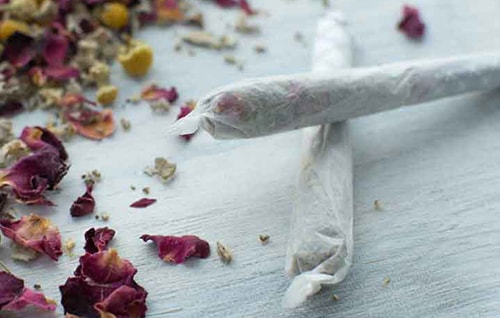
Takeaway
Smoking herbal blends are not only useful in alleviating health issues. It is also popular with people wanting to quit smoking and give up tobacco addiction. Herbs like lobelia have a similar effect to nicotine but they bind with the brain’s nicotine receptor to tame its cravings.
Herbal cigarettes are generally not addictive but you should take caution when using them as a smoking blend. They still produce carbon monoxide, tar and particles that are harmful to the lungs in prolonged use.
Just as you consume herbs in different forms, smoked herbs are also potent and may give undesirable side effects. So before taking herbs in any form and way, please consult a naturopathic doctor.

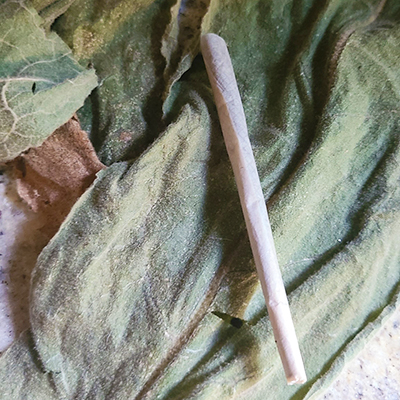
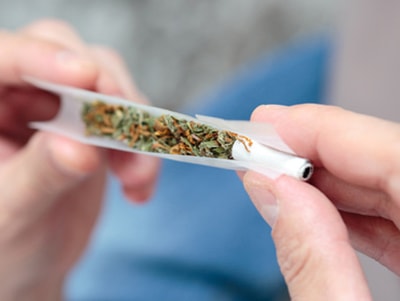
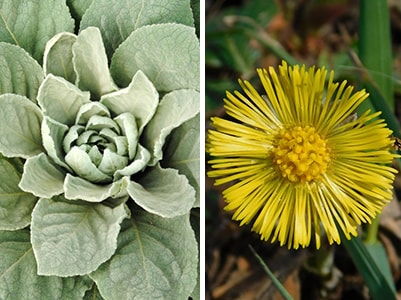
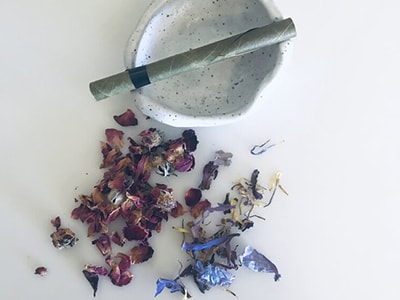
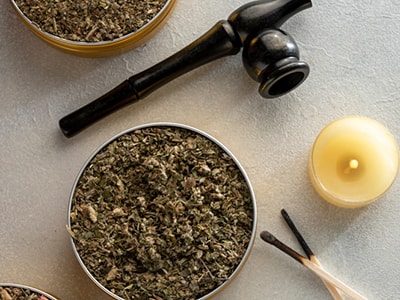
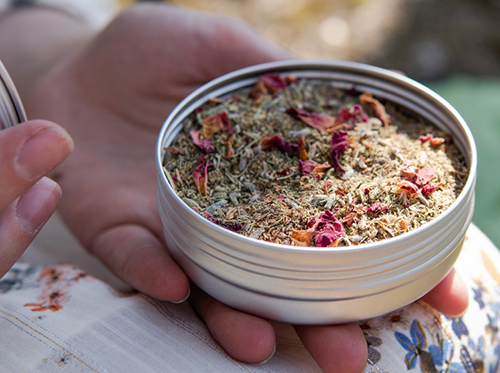
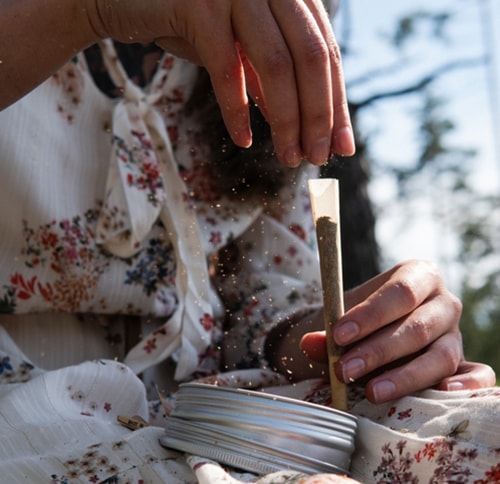 Enjoy the smoke and don’t forget to store them in a dry glass jar or a plastic pouch.
Enjoy the smoke and don’t forget to store them in a dry glass jar or a plastic pouch.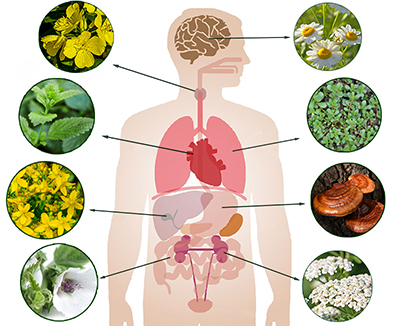
I do not smoke! This information is helpful to those who do.
Can you use a pipe or bong for these?
Hi Kim,
Yes, you can use them instead.
Many blessings and good health!
Do not smoke anything damp or wet-EVER.
Be sure everything is completely dry before putting it in a container or you will have mold .and that should not be inhaled.
Agree💯
I’m not to sure inhaling smoke of any type would be benificial to your health physically or mentally. Maybe better to ingest this as a food to avoid lung damage .
its actually one of the best ways to get the benefits of herbs. Native American Indians did this all the time aside from Tobacco. there is a massive disinfo campaign done by anti tobacco lobby that creates the hysteria that all smoking bad. no, actual tobacco is not harmful (tho yes, nicotine is addictive, it is also naturally beneficial for many things) it was all the additives the big tobacco put into the cigarettes that caused the harm.
I stopped smoking 25 years ago, and substituted with hemp/sativa, and have smoked that for over 40 years, and have ZERO lung issues, breathing issues and no health issues of any kind. I used to smoke both cannabis and tobacco (big tobacco back in the day) and the cigarettes caused me lots of issues. my dr told me to pick one, i picked the sativa. needless to say, i have never been sorry for choosing it, i have lived a long and healthy life.
The only reason not to try herbal smokes is preference, and or if you do have any type of lung disease or issues such as asthma/allergic, which some herbs can help with asthma, but some you could be allergic to.
injesting is good, but your stomach acid destroys about 50-80% of the benefits and smoking gives you a clear 90-100% of the benefits.
Wow, this is such a beautiful alternative for those addicted to tobacco, and to bring back a more ceremonial appreciation and ritualistic application of smoking, not to mention the healing benefits of some of these herbs. Thanks so much for sharing.
Hi Naomi,
You’re very welcome! We’re happy to hear the article is helpful for you.
Many blessings and good health!
I would love to try the uplifting blend but can not find a source. Can you, or someone, steer me in the right direction? I would like to purchase the actual blend or, it’s ingredients seperately. Either way is fin.
Thank you for ALL the great info I receive!
Try Mountain Rose Herbs. They are the very best source.